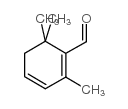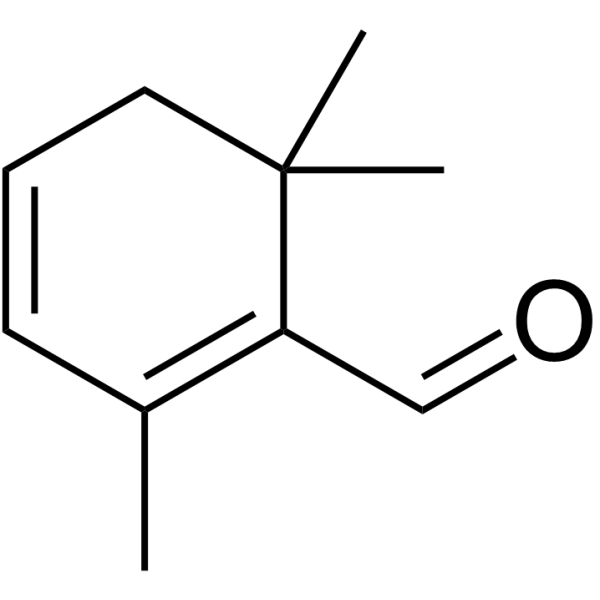2,3-二氢-2,2,6-三甲基苯甲醛,2,6,6-Trimethyl-1,3-Cyclohexadiene-1-Carboxaldehyde,80%
产品编号:西域试剂-WR38747| CAS NO:116-26-7| MDL NO:MFCD00209531| 分子式:C10H14O| 分子量:150.22
Safranal 是藏红花 (Crocus sativus) 的主要成分,具有口服活性,是这种香料的独特香气来源。Safranal 具有神经保护和抗炎作用,并有用于帕金森氏病的研究潜力。
本网站销售的所有产品仅用于工业应用或者科学研究等非医疗目的,不可用于人类或动物的临床诊断或者治疗,非药用,非食用,
| 产品名称 | 2,3-二氢-2,2,6-三甲基苯甲醛 | ||||||||||||||||
|---|---|---|---|---|---|---|---|---|---|---|---|---|---|---|---|---|---|
| 英文名称 | 2,6,6-Trimethyl-1,3-Cyclohexadiene-1-Carboxaldehyde | ||||||||||||||||
| CAS编号 | 116-26-7 | ||||||||||||||||
| 产品描述 | Safranal 是藏红花 (Crocus sativus) 的主要成分,具有口服活性,是这种香料的独特香气来源。Safranal 具有神经保护和抗炎作用,并有用于帕金森氏病的研究潜力。 | ||||||||||||||||
| 产品沸点 | 217.3ºC at 760 mmHg | ||||||||||||||||
| 产品密度 | 0.975 g/cm3 | ||||||||||||||||
| 产品闪点 | 80.4ºC | ||||||||||||||||
| 精确质量 | 150.10400 | ||||||||||||||||
| PSA | 17.07000 | ||||||||||||||||
| LogP | 2.48790 | ||||||||||||||||
| 外观性状 | 液体 | ||||||||||||||||
| 蒸气压 | 0.134mmHg at 25°C | ||||||||||||||||
| 折射率 | n20/D 1.523(lit.) | ||||||||||||||||
| 溶解性数据 | In Vitro:
Ethanol : 100 mg/mL (665.69 mM; Need ultrasonic) DMSO : 100 mg/mL (665.69 mM; Need ultrasonic) 配制储备液
*
请根据产品在不同溶剂中的溶解度选择合适的溶剂配制储备液;一旦配成溶液,请分装保存,避免反复冻融造成的产品失效。 In Vivo:
请根据您的实验动物和给药方式选择适当的溶解方案。以下溶解方案都请先按照 In Vitro 方式配制澄清的储备液,再依次添加助溶剂:
——为保证实验结果的可靠性,澄清的储备液可以根据储存条件,适当保存;体内实验的工作液,建议您现用现配,当天使用;
以下溶剂前显示的百
| ||||||||||||||||
| 体外研究 | 藏红花醛(10-50μM;1h)剂量依赖性地降低LPS诱导的RAW264.7细胞和BMDMs中的iNOS和COX-2水平。藏红花醛(10-50μM;作用1h)抑制脂多糖(LPS)刺激的RAW 264.7细胞中细胞因子IL-6和TNF-α的产生和mRNA的表达。藏红花醛(10,50μM;1h后用1μg/ml LPS刺激30min)抑制脂多糖(LPS)刺激的RAW264.7细胞中NF-κB和AP-1的核转位。Western Blot分析细胞系:RAW264.7细胞和骨髓源性巨噬细胞(BMDMs)浓度:10,50μM孵育时间:在脂多糖(LPS)刺激前1h(1µg/ml)结果:LPS诱导的RAW264.7细胞和BMDMs中iNOS和COX-2水平均呈剂量依赖性降低。抑制MAPK途径蛋白细胞外信号调节激酶(ERK)、c-Jun N末端激酶(JNK)、p38的磷酸化。抑制NF-κB途径蛋白IKKα/β和IκBα及IκBα的降解。RT-PCR细胞株:RAW 264.7细胞浓度:10,50μM孵育时间:1h后用LPS(1μg/ml)刺激24h。结果:抑制了脂多糖(LPS)刺激的RAW 264.7细胞中细胞因子IL-6、TNF-α的产生和mRNA的表达。 | ||||||||||||||||
| 体内研究 | 藏红花醛(200-500 mg/kg;PO;持续7天)使结肠长度和体重减轻百分比略有恢复,DAI评分明显较低。动物模型:雌性BALB/c小鼠(18-20g)(DSS诱导的结肠炎小鼠)剂量:200500mg/kg给药:PO;连续7天结果:使结肠长度和体重减轻率略有恢复,DAI评分明显降低。 | ||||||||||||||||
| 稳定性 | 1. 存在于烤烟烟叶、香料烟烟叶中。 2. 天然存在于藏红花油中。 | ||||||||||||||||
| 储存条件 | -20°C;存放于惰性气体之中;避免光,空气,加热 |
相关文档
化学品安全说明书(MSDS)
下载MSDS质检证书(COA)
相关产品
| 符号 |

GHS07 |
|---|---|
| 信号词 | Warning |
| 危害声明 | H315-H319-H335 |
| 警示性声明 | P261-P305 + P351 + P338 |
| 个人防护装备 | Eyeshields;full-face respirator (US);Gloves;multi-purpose combination respirator cartridge (US);type ABEK (EN14387) respirator filter |
| 危害码 (欧洲) | Xi: Irritant; |
| 风险声明 (欧洲) | R36/37/38 |
| 安全声明 (欧洲) | 26-36 |
| WGK德国 | 3 |
| 海关编码 | 2912299000 |
|
SECTION 1: Identification of the substance/mixture and of the company/undertaking Product identifiers Product name: Safranal REACH No.: A registration number is not available for this substance as the substance or its uses are exempted from registration, the annual tonnage does not require a registration or the registration is envisaged for a later registration deadline.
CAS-No.: 116-26-7 Relevant identified uses of the substance or mixture and uses advised against Identified uses: Laboratory chemicals, Manufacture of substances SECTION 2: Hazards identification Classification of the substance or mixture Classification according to Regulation (EC) No 1272/2008 Skin irritation (Category 2), H315 Eye irritation (Category 2), H319 Specific target organ toxicity - single exposure (Category 3), H335 For the full text of the H-Statements mentioned in this Section, see Section 16. Classification according to EU Directives 67/548/EEC or 1999/45/EC Xi IrritantR36/37/38 For the full text of the R-phrases mentioned in this Section, see Section 16. Label elements Labelling according Regulation (EC) No 1272/2008 Pictogram Signal wordWarning Hazard statement(s) H315Causes skin irritation. H319Causes serious eye irritation. H335May cause respiratory irritation. Precautionary statement(s) P261Avoid breathing vapours. P305 + P351 + P338IF IN EYES: Rinse cautiously with water for several minutes. Remove contact lenses, if present and easy to do. Continue rinsing. Supplemental Hazardnone Statements Other hazards - none SECTION 3: Composition/information on ingredients Substances Synonyms: 2,3-Dihydro-2,2,6-trimethylbenzaldehyde Formula: C10H14O Molecular Weight: 150,22 g/mol CAS-No.: 116-26-7 EC-No.: 204-133-7 Hazardous ingredients according to Regulation (EC) No 1272/2008 ComponentClassificationConcentration 2,3-Dihydro-2,2,6-trimethylbenzaldehyde CAS-No.116-26-7Skin Irrit. 2; Eye Irrit. 2; STOT<= 100 % EC-No.204-133-7SE 3; H315, H319, H335 Hazardous ingredients according to Directive 1999/45/EC ComponentClassificationConcentration 2,3-Dihydro-2,2,6-trimethylbenzaldehyde CAS-No.116-26-7Xi, R36/37/38<= 100 % EC-No.204-133-7 For the full text of the H-Statements and R-Phrases mentioned in this Section, see Section 16 SECTION 4: First aid measures Description of first aid measures General advice Consult a physician. Show this safety data sheet to the doctor in attendance. If inhaled If breathed in, move person into fresh air. If not breathing, give artificial respiration. Consult a physician. In case of skin contact Wash off with soap and plenty of water. Consult a physician. In case of eye contact Rinse thoroughly with plenty of water for at least 15 minutes and consult a physician. If swallowed Do NOT induce vomiting. Never give anything by mouth to an unconscious person. Rinse mouth with water. Consult a physician. Most important symptoms and effects, both acute and delayed The most important known symptoms and effects are described in the labelling (see section 2.2) and/or in section 11 Indication of any immediate medical attention and special treatment needed no data available SECTION 5: Firefighting measures Extinguishing media Suitable extinguishing media Use water spray, alcohol-resistant foam, dry chemical or carbon dioxide. Special hazards arising from the substance or mixture Carbon oxides Advice for firefighters Wear self contained breathing apparatus for fire fighting if necessary. Further information Use water spray to cool unopened containers. SECTION 6: Accidental release measures Personal precautions, protective equipment and emergency procedures Use personal protective equipment. Avoid breathing vapours, mist or gas. Ensure adequate ventilation. Remove all sources of ignition. Evacuate personnel to safe areas. Beware of vapours accumulating to form explosive concentrations. Vapours can accumulate in low areas. For personal protection see section 8. Environmental precautions Prevent further leakage or spillage if safe to do so. Do not let product enter drains. Methods and materials for containment and cleaning up Contain spillage, and then collect with an electrically protected vacuum cleaner or by wet-brushing and place in container for disposal according to local regulations (see section 13). Keep in suitable, closed containers for disposal. Reference to other sections For disposal see section 13. SECTION 7: Handling and storage Precautions for safe handling Avoid contact with skin and eyes. Avoid inhalation of vapour or mist. Keep away from sources of ignition - No smoking.Take measures to prevent the build up of electrostatic charge. For precautions see section 2.2. Conditions for safe storage, including any incompatibilities Store in cool place. Keep container tightly closed in a dry and well-ventilated place. Containers which are opened must be carefully resealed and kept upright to prevent leakage. Specific end use(s) Apart from the uses mentioned in section 1.2 no other specific uses are stipulated SECTION 8: Exposure controls/personal protection Control parameters Components with workplace control parameters Exposure controls Appropriate engineering controls Handle in accordance with good industrial hygiene and safety practice. Wash hands before breaks and at the end of workday. Personal protective equipment Eye/face protection Safety glasses with side-shields conforming to EN166 Use equipment for eye protection tested and approved under appropriate government standards such as NIOSH (US) or EN 166(EU). Skin protection Handle with gloves. Gloves must be inspected prior to use. Use proper glove removal technique (without touching glove's outer surface) to avoid skin contact with this product. Dispose of contaminated gloves after use in accordance with applicable laws and good laboratory practices. Wash and dry hands. The selected protective gloves have to satisfy the specifications of EU Directive 89/686/EEC and the standard EN 374 derived from it. Body Protection impervious clothing, The type of protective equipment must be selected according to the concentration and amount of the dangerous substance at the specific workplace. Respiratory protection Where risk assessment shows air-purifying respirators are appropriate use a full-face respirator with multi-purpose combination (US) or type ABEK (EN 14387) respirator cartridges as a backup to engineering controls. If the respirator is the sole means of protection, use a full-face supplied air respirator. Use respirators and components tested and approved under appropriate government standards such as NIOSH (US) or CEN (EU). Control of environmental exposure Prevent further leakage or spillage if safe to do so. Do not let product enter drains. SECTION 9: Physical and chemical properties Information on basic physical and chemical properties a) AppearanceForm: clear, liquid Colour: yellow b) Odourno data available c) Odour Thresholdno data available d) pHno data available e) Melting point/freezingno data available point f) Initial boiling point and 70 °C at 1 hPa - lit. boiling range g) Flash point86 °C - closed cup h) Evapouration rateno data available i) Flammability (solid, gas) no data available j) Upper/lowerno data available flammability or explosive limits k) Vapour pressureno data available l) Vapour densityno data available m) Relative density0,966 g/cm3 at 25 °C n) Water solubilityno data available o) Partition coefficient: n- no data available octanol/water p) Auto-ignitionno data available temperature q) Decompositionno data available temperature r) Viscosityno data available s) Explosive propertiesno data available t) Oxidizing propertiesno data available Other safety information no data available SECTION 10: Stability and reactivity Reactivity no data available Chemical stability Stable under recommended storage conditions. Possibility of hazardous reactions no data available Conditions to avoid Heat, flames and sparks. Incompatible materials Strong oxidizing agents, Strong acids, Strong bases Hazardous decomposition products Other decomposition products - no data available In the event of fire: see section 5 SECTION 11: Toxicological information Information on toxicological effects Acute toxicity no data available Skin corrosion/irritation no data available Serious eye damage/eye irritation no data available Respiratory or skin sensitisation no data available Germ cell mutagenicity no data available Carcinogenicity IARC:No component of this product present at levels greater than or equal to 0.1% is identified as probable, possible or confirmed human carcinogen by IARC. Reproductive toxicity no data available Specific target organ toxicity - single exposure Inhalation - May cause respiratory irritation. Specific target organ toxicity - repeated exposure no data available Aspiration hazard no data available Additional Information RTECS: Not available To the best of our knowledge, the chemical, physical, and toxicological properties have not been thoroughly investigated. SECTION 12: Ecological information Toxicity no data available Persistence and degradability no data available Bioaccumulative potential no data available Mobility in soil no data available Results of PBT and vPvB assessment PBT/vPvB assessment not available as chemical safety assessment not required/not conducted Other adverse effects no data available SECTION 13: Disposal considerations Waste treatment methods Product This combustible material may be burned in a chemical incinerator equipped with an afterburner and scrubber. Offer surplus and non-recyclable solutions to a licensed disposal company. Contaminated packaging Dispose of as unused product. SECTION 14: Transport information UN number ADR/RID: -IMDG: -IATA: - UN proper shipping name ADR/RID: Not dangerous goods IMDG: Not dangerous goods IATA:Not dangerous goods Transport hazard class(es) ADR/RID: -IMDG: -IATA: - Packaging group ADR/RID: -IMDG: -IATA: - Environmental hazards ADR/RID: noIMDG Marine pollutant: noIATA: no Special precautions for user no data available SECTION 15: Regulatory information This safety datasheet complies with the requirements of Regulation (EC) No. 1907/2006. Safety, health and environmental regulations/legislation specific for the substance or mixture no data available Chemical Safety Assessment For this product a chemical safety assessment was not carried out SECTION 16: Other information Full text of H-Statements referred to under sections 2 and 3. Eye Irrit.Eye irritation H315Causes skin irritation. H319Causes serious eye irritation. H335May cause respiratory irritation. Skin Irrit.Skin irritation STOT SESpecific target organ toxicity - single exposure Full text of R-phrases referred to under sections 2 and 3 XiIrritant R36/37/38Irritating to eyes, respiratory system and skin. Further information Copyright 2014 Co. LLC. License granted to make unlimited paper copies for internal use only. The above information is believed to be correct but does not purport to be all inclusive and shall be used only as a guide. The information in this document is based on the present state of our knowledge and is applicable to the product with regard to appropriate safety precautions. It does not represent any guarantee of the properties of the product. Corporation and its Affiliates shall not be held liable for any damage resulting from handling or from contact with the above product. See and/or the reverse side of invoice or packing slip for additional terms and conditions of sale. |









 浙公网安备 33010802013016号
浙公网安备 33010802013016号